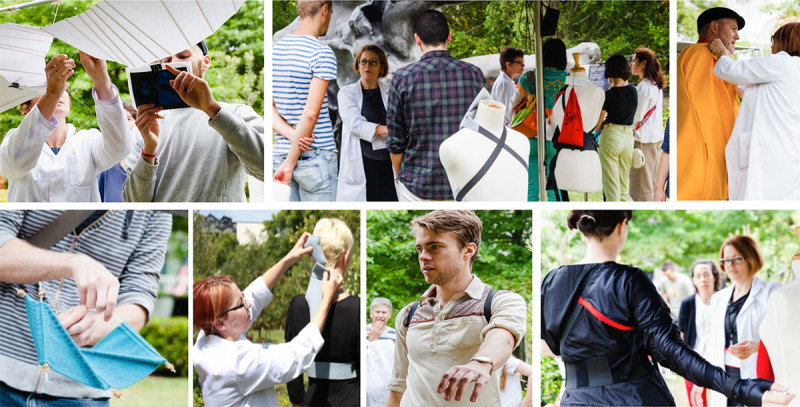Overview
The aim of PKI is to understand how to give people the feeling of being in someone else’s body, someone with different physical abilities and constraints […]. The first design probes that emerged from this inquiry are Green Knits, Blue Cushions and Sleeves. These probes were tested at a Lab in the Wild at The National Gallery of Victoria, International, in Melbourne Australia, in January and February, 2014. The purpose was to invite the public into considered engagement of the ethical, social, personal, political and cultural implications of the PKI project.
A Lab in the Wild transplants the research in process – including the research and the researchers – into a public setting as a constantly evolving participatory exhibit. The intention is to fruitfully disrupt participant, as well as researcher expectations. This framing requires researchers to adapt responsively to emerging insights; to rapidly prototype and test ideas in situ: to openly and responsively craft the research, as well as the research structure. In this process, interaction with each participant is fluidly negotiated by the researchers, who gently follow and guide participants through a dynamic process of discovery and exchange, led by emergent curiosity and the range of prototypes on offer. The result is an interwoven exchange that is at once material, embodied and conversational.

We welcomed hundreds of participants of all ages, socio-economic, cultural and physical backgrounds to play with the probes.
There was much curiosity in the act of observing us crafting on site. Comments such as “my mother knitted” led to conversations that might not otherwise have occurred. Seeing us at work with our hands was highly accessible. It blurred boundaries between making and testing. Craft, when thought of as a verb, offers a dynamic, sensory and performative way to enable engagement that is inclusive and non-threatening. Drawing on the constant interplay between tacit knowledge and self-conscious awareness of craft enabled us to reach out and connect with participants. Within this context, the social dimension of craft proved highly valuable.

The Lab in the Wild provided a structure for ongoing experimentation and allowed for risk-taking with our research framework. We were able to continue crafting prototypes on site, make adjustments to pieces, and create new prototypes in response to what was happening. This process led us to revalue the unresolved prototype, our fluid and emergent engagement with process, and with members of a broad range of social and cultural groups.